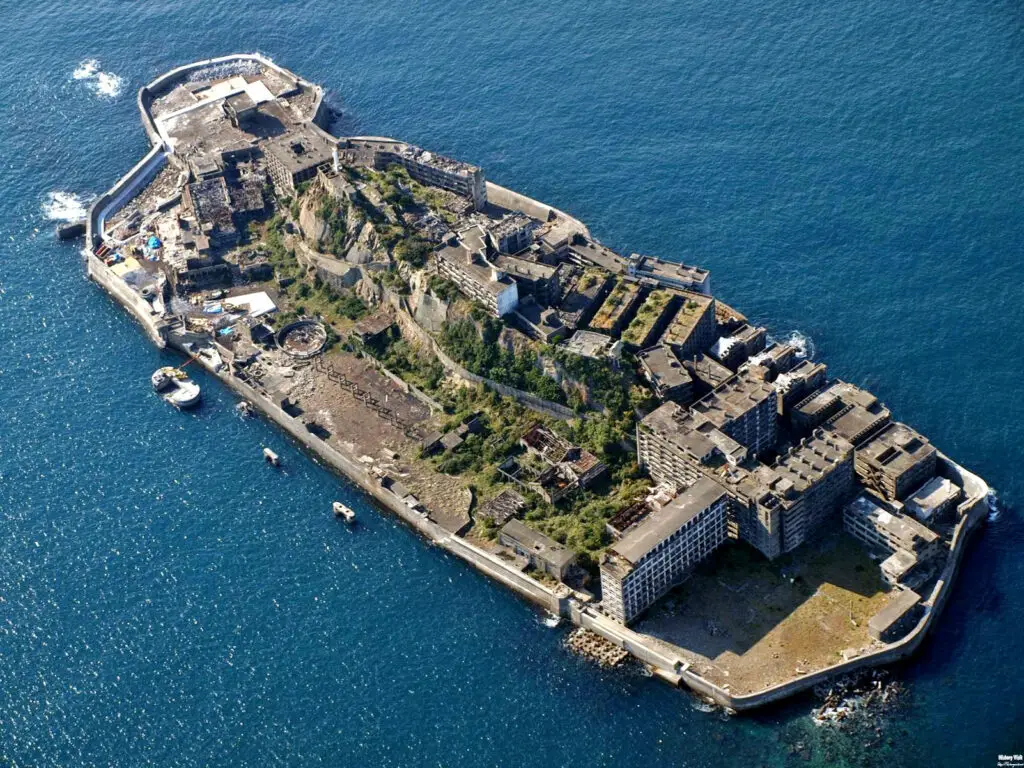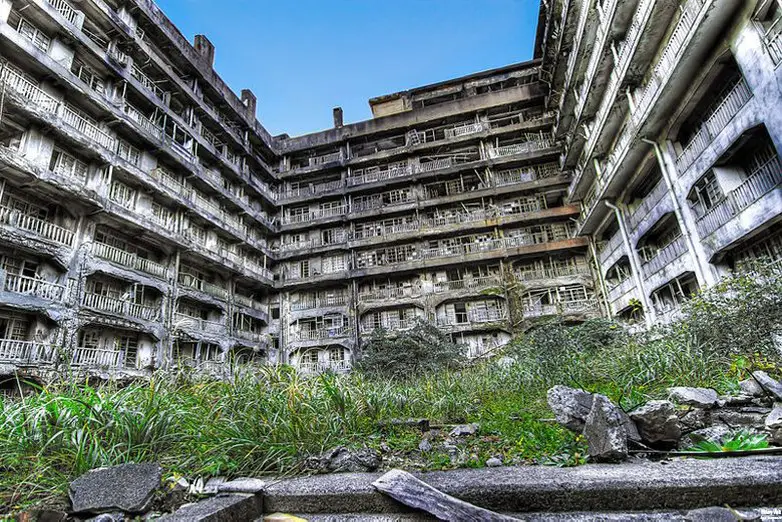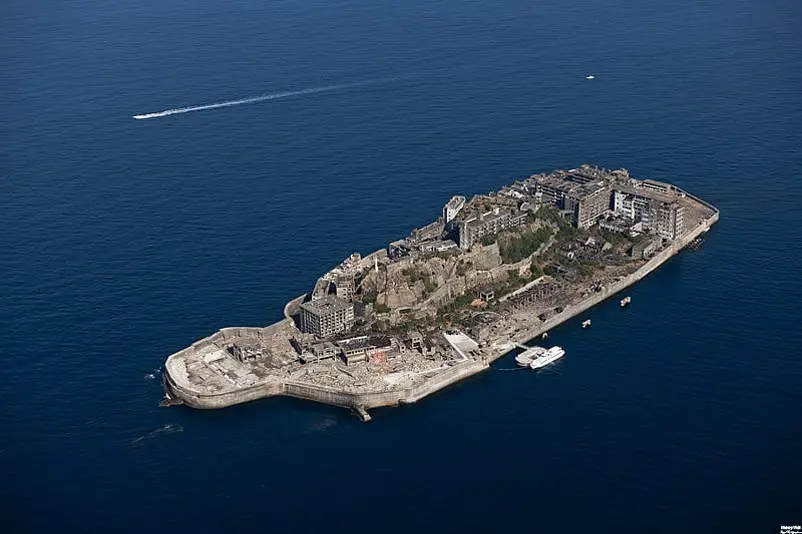Gunkanjima: The Rise and Fall of Hashima Island, Japan’s Ghost Island

Introduction
Hashima Island, more commonly known as Gunkanjima or “Battleship Island,” is one of the most iconic and eerie symbols of Japan’s industrial past. Located 15 kilometers off the coast of Nagasaki, this once-thriving coal mining facility now stands abandoned, its towering concrete buildings weathered by time and the elements. Gunkanjima’s rise and fall tell a compelling story of rapid industrialization, economic prosperity, and eventual decline, leaving behind a ghostly relic that continues to captivate the imagination of historians, tourists, and filmmakers alike.
The story of Hashima Island begins in the late 19th century, during Japan’s Meiji era, when the nation was rapidly modernizing and industrializing. The discovery of rich coal deposits under the seabed transformed the island into a bustling hub of activity, attracting workers and their families from across the country. Under the ownership of the Mitsubishi Corporation, Gunkanjima grew into one of the most densely populated places on Earth, with a peak population of over 5,000 people living on just 16 acres of land.
Today, Hashima Island is a stark reminder of the impermanence of human endeavor. Its abandoned buildings and deserted streets serve as a poignant testament to the boom-and-bust cycles of industrial progress. This article explores the historical background and establishment of Gunkanjima, its peak and decline, and its modern rediscovery as a symbol of Japan’s industrial heritage.
Early History
The history of Hashima Island dates back to 1887, when coal was first discovered beneath its seabed. At the time, Japan was in the midst of the Meiji Restoration, a period marked by rapid modernization and industrialization. Recognizing the potential of the coal deposits, the Mitsubishi Corporation acquired the island in 1890 and began extensive mining operations. This marked the beginning of Hashima’s transformation from a barren rock into a bustling industrial hub.
Mitsubishi’s investment in Hashima was significant. The company constructed extensive sea walls to protect the island from typhoons and rough seas, allowing for the safe extraction of coal. As mining operations expanded, so did the need for a workforce. Mitsubishi built residential buildings, schools, hospitals, and entertainment facilities to accommodate the influx of workers and their families. By the early 20th century, Hashima had evolved into a self-sufficient community, complete with all the amenities of a small city.
Life on Hashima was both challenging and unique. The island’s limited space and harsh working conditions were offset by the strong sense of community among its residents. Despite the high population density, Hashima boasted a well-organized infrastructure, with multi-story concrete apartment buildings, a communal bathhouse, and even a swimming pool. The residents of Hashima took pride in their tight-knit community, which thrived amidst the industrial landscape.
Life on Hashima Island
Life on Hashima Island was a unique blend of industrial rigor and community spirit. At its peak, the island housed over 5,000 residents in tightly packed apartment buildings, making it one of the most densely populated places in the world. The living conditions, although cramped, were relatively advanced for the time, with most apartments equipped with modern conveniences such as electricity, running water, and indoor plumbing. Mitsubishi ensured that the island had all the necessary amenities to support its population, including schools, a hospital, shops, and recreational facilities.
The daily routine on Hashima was dictated by the rhythms of the coal mines. Workers, who comprised the majority of the adult population, labored in grueling conditions deep beneath the sea. The work was dangerous, with risks of explosions, cave-ins, and exposure to coal dust. Despite these hazards, many workers felt a strong sense of purpose and camaraderie. The island’s isolated location fostered a close-knit community where everyone knew each other and looked out for one another.
Social life on Hashima was centered around communal activities and shared spaces. Residents enjoyed communal bathhouses, sports facilities, and a variety of cultural and recreational activities. Festivals, movie screenings, and public events provided much-needed entertainment and a sense of normalcy amidst the industrial backdrop. Children attended the island’s schools, which offered education up to junior high level, while adults engaged in social clubs and community organizations. This strong sense of community helped residents cope with the challenges of island life and created lasting bonds among them.
Economic Boom
Hashima Island’s economic boom was driven by the high demand for coal, which was a critical energy source for Japan’s rapidly growing industrial sector. During the first half of the 20th century, coal production on Hashima reached its zenith, with the island producing over 400,000 tons of coal annually. This output was made possible by advanced mining techniques and a highly efficient workforce, making Hashima one of the most productive coal mines in Japan.
The economic prosperity of Hashima attracted workers from across the country, contributing to its dense population. The island’s infrastructure expanded to accommodate this influx, with the construction of additional residential buildings, schools, and recreational facilities. Mitsubishi invested heavily in improving living conditions, ensuring that residents had access to modern amenities and a relatively high standard of living. This investment paid off, as the island’s productivity continued to climb, solidifying its reputation as a cornerstone of Japan’s industrial might.
However, the boom years were not without their challenges. The island’s confined space and industrial nature meant that environmental conditions were harsh. Air pollution from coal dust and limited green spaces were everyday realities for Hashima’s residents. Despite these hardships, the economic opportunities provided by the coal mines outweighed the drawbacks for many workers and their families. The sense of purpose and community on the island helped to mitigate the difficulties of life in such an intense environment.
Decline of the Coal Industry

The decline of Hashima Island began in the 1960s, as Japan’s energy policy shifted from coal to oil. The discovery of oil in the Middle East and the development of more efficient and cleaner energy sources led to a decrease in the demand for coal. This shift had a profound impact on Hashima, which had relied entirely on coal mining for its economic viability. As demand dwindled, so did the island’s productivity and workforce, marking the beginning of its decline.
The decline was gradual but inevitable. Mitsubishi reduced mining operations and began scaling back its investment in the island’s infrastructure. The once-thriving community started to shrink as workers and their families left in search of better opportunities on the mainland. By the early 1970s, the island’s population had dwindled significantly, and the remaining residents faced an uncertain future. The sense of community that had once defined Hashima was eroding, replaced by a growing sense of abandonment and despair.
In 1974, Mitsubishi officially announced the closure of the Hashima coal mine. The decision marked the end of an era and the beginning of the island’s transformation into a ghost town. The remaining residents were evacuated, and the island was left deserted. The rapid abandonment of Hashima left behind a haunting landscape of empty buildings, rusting machinery, and overgrown pathways. The once-bustling community had vanished, leaving only the echoes of its industrial past.
Conclusion

Hashima Island’s story is a testament to the rapid rise and fall of industrial communities. From its early days as a barren rock to its peak as a densely populated industrial hub, Gunkanjima symbolizes both the potential and the pitfalls of industrial progress. The island’s abandonment serves as a poignant reminder of the impermanence of human endeavors and the impact of economic shifts on communities.
Today, Hashima Island stands as a ghostly relic, attracting tourists and researchers who seek to understand its history and the lives of those who once called it home. The island’s haunting beauty and eerie silence offer a stark contrast to its bustling past, providing a unique glimpse into a bygone era. As a symbol of Japan’s industrial heritage, Hashima continues to captivate the imagination and serve as a reminder of the complex interplay between industry, community, and the environment.
The legacy of Hashima Island is one of resilience and adaptation. The former residents, many of whom maintain strong ties to their island home, continue to share their stories and memories, ensuring that the spirit of Hashima lives on. The island’s history offers valuable lessons about the consequences of industrialization and the importance of sustainable development, reminding us of the need to balance progress with preservation.


